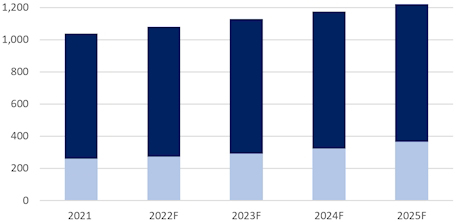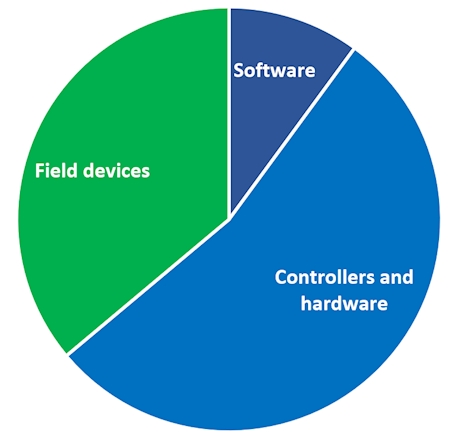Building Automation and Controls in light commercial buildings
New BSRIA Worldwide Market Intelligence (WMI) study covering Germany, Italy, France, and the UK estimates the market for building automation controls in light commercial buildings at EUR 275 million in 2022.
The building automation software, controllers, hardware, and field devices installed in light commercial buildings account for a significant share of overall BACS product sales in the four major European markets estimated at EUR 1.1 billion.
Most BACS products installed in light commercial buildings are found in offices, with 40-50% share, followed by hotels, education, health, retail and mixed-use buildings with some variation in each country.

|
| Source: BSRIA Worldwide Market Intelligence |
It is also worth noting that building automation controls products sold to the light commercial building segment are expected to grow at a higher rate than the overall BACS market, particularly in 2024 and 2025 with 11% and 13% respectively. Most of the European economies showed good economic growth in 2021, but Russia's invasion of Ukraine is increasingly impacting economies in 2022.
On the positive side, the European Energy Performance of Buildings Directive (EPBD) drives the adoption of BACS to optimise energy use through better automation, control, and monitoring. In December 2021, the European Commission proposed a new directive that states that non-residential buildings will have to be renovated and improved to at least energy performance grade F by 2027 and grade E by 2030 as part of European Union’s net zero-emission strategy.
Over half the sales are accounted for by controllers and hardware, followed by field devices, and then software.

|
| Source: BSRIA Worldwide Market Intelligence |
BSRIA WMI's BACS in Light Commercial Buildings study includes products falling within the following definitions:
- Professionally installed systems.
- A minimum of two or more interconnected systems (HVAC, lighting, blinds, occupancy sensors, security etc.).
- Open systems/platforms with protocols such as KNX, BACnet and LON.
- Wired controllers/systems with the capability to integrate wireless devices and cloud connection.
- Most systems installed in buildings with floor space below 25,000 sq. ft or 2,323 m2.
The value is in Manufacturer Selling Prices (MSP) covering products (not labour). The study does not cover plug & play products installed in the residential market, nor does it cover systems connected to big plant equipment.
The study is part of BSRIA WMI’s BACS and Smart building portfolio, which includes world studies on building automation and publications on field devices (valves, actuators and sensors). BSRIA WMI is a leading provider of studies covering building services such as structured cabling, building controls, air conditioning, ventilation, refrigeration & refrigerants, and heat pumps.
This article originally appeared on the BSRIA News and Blog site under the same title dated August 2022.
--BSRIA
[edit] Related articles on Buildings Design
- BACS building automation controls - the information revolution.
- BS EN 15232 Energy performance of buildings: impact of building automation, controls and building management.
- BSRIA articles.
- Building management systems BMS.
- Intelligent building management systems IBMS.
- Use class designation for land and buildings.
Featured articles and news
RTPI leader to become new CIOB Chief Executive Officer
Dr Victoria Hills MRTPI, FICE to take over after Caroline Gumble’s departure.
Social and affordable housing, a long term plan for delivery
The “Delivering a Decade of Renewal for Social and Affordable Housing” strategy sets out future path.
A change to adoptive architecture
Effects of global weather warming on architectural detailing, material choice and human interaction.
The proposed publicly owned and backed subsidiary of Homes England, to facilitate new homes.
How big is the problem and what can we do to mitigate the effects?
Overheating guidance and tools for building designers
A number of cool guides to help with the heat.
The UK's Modern Industrial Strategy: A 10 year plan
Previous consultation criticism, current key elements and general support with some persisting reservations.
Building Safety Regulator reforms
New roles, new staff and a new fast track service pave the way for a single construction regulator.
Architectural Technologist CPDs and Communications
CIAT CPD… and how you can do it!
Cooling centres and cool spaces
Managing extreme heat in cities by directing the public to places for heat stress relief and water sources.
Winter gardens: A brief history and warm variations
Extending the season with glass in different forms and terms.
Restoring Great Yarmouth's Winter Gardens
Transforming one of the least sustainable constructions imaginable.
Construction Skills Mission Board launch sector drive
Newly formed government and industry collaboration set strategy for recruiting an additional 100,000 construction workers a year.
New Architects Code comes into effect in September 2025
ARB Architects Code of Conduct and Practice available with ongoing consultation regarding guidance.
Welsh Skills Body (Medr) launches ambitious plan
The new skills body brings together funding and regulation of tertiary education and research for the devolved nation.
Paul Gandy FCIOB announced as next CIOB President
Former Tilbury Douglas CEO takes helm.
UK Infrastructure: A 10 Year Strategy. In brief with reactions
With the National Infrastructure and Service Transformation Authority (NISTA).























